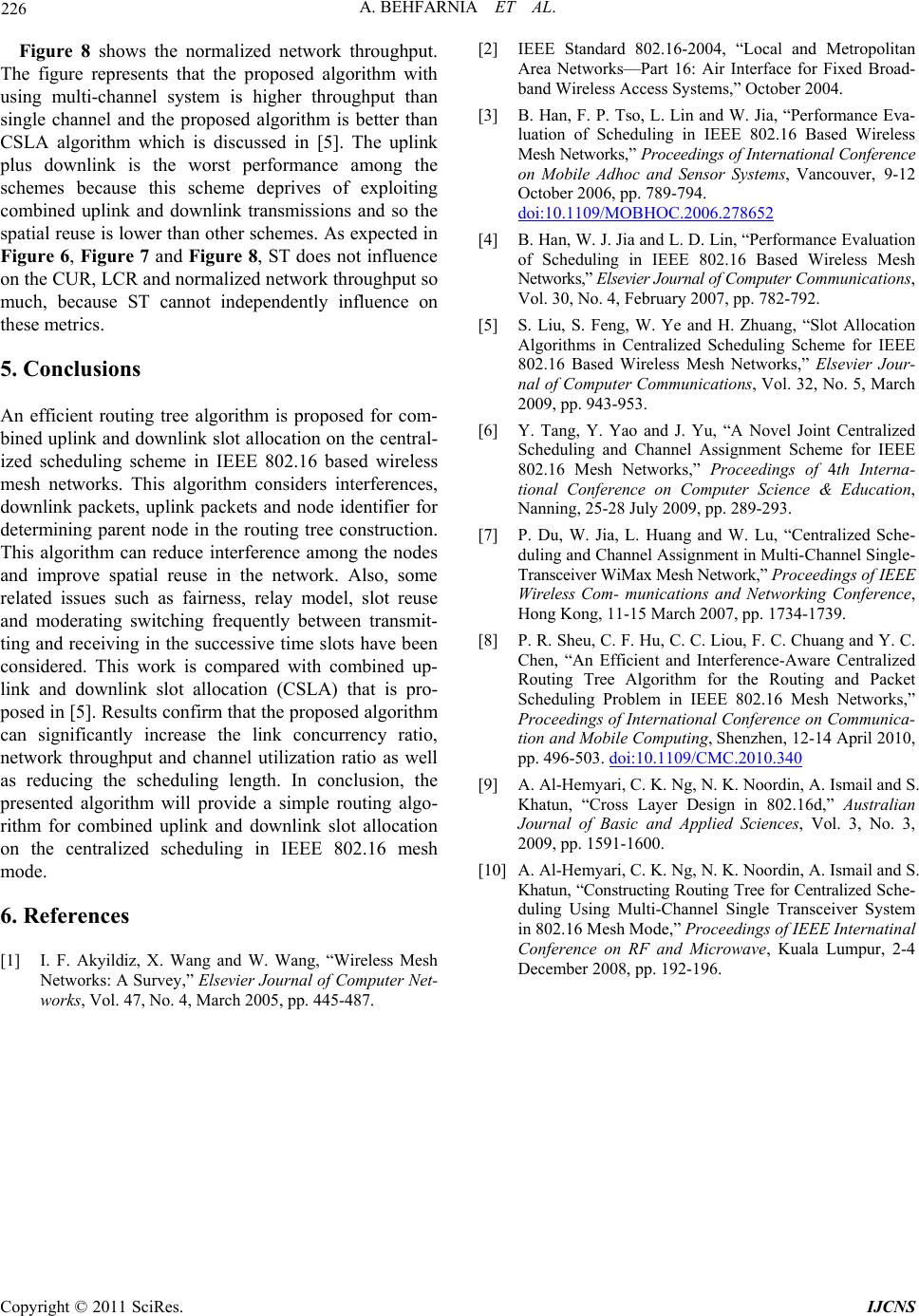
A. BEHFARNIA ET AL.
Copyright © 2011 SciRes. IJCNS
226
Figure 8 shows the normalized network throughput.
The figure represents that the proposed algorithm with
using multi-channel system is higher throughput than
single channel and the proposed algorithm is better than
CSLA algorithm which is discussed in [5]. The uplink
plus downlink is the worst performance among the
schemes because this scheme deprives of exploiting
combined uplink and downlink transmissions and so the
spatial reuse is lower than other schemes. As expected in
Figure 6, Figure 7 and Figure 8, ST does not influence
on the CUR, LCR and normalized network throughput so
much, because ST cannot independently influence on
these metrics.
5. Conclusions
An efficient routing tree algorithm is proposed for com-
bined uplink and downlink slot allocation on the central-
ized scheduling scheme in IEEE 802.16 based wireless
mesh networks. This algorithm considers interferences,
downlink packets, uplink packets and node identifier for
determining parent node in the routing tree construction.
This algorithm can reduce interference among the nodes
and improve spatial reuse in the network. Also, some
related issues such as fairness, relay model, slot reuse
and moderating switching frequently between transmit-
ting and receiving in the successive time slots have been
considered. This work is compared with combined up-
link and downlink slot allocation (CSLA) that is pro-
posed in [5]. Results confirm that the proposed algorithm
can significantly increase the link concurrency ratio,
network throughput and channel utilization ratio as well
as reducing the scheduling length. In conclusion, the
presented algorithm will provide a simple routing algo-
rithm for combined uplink and downlink slot allocation
on the centralized scheduling in IEEE 802.16 mesh
mode.
6. References
[1] I. F. Akyildiz, X. Wang and W. Wang, “Wireless Mesh
Networks: A Survey,” Elsevier Journal of Computer Net-
works, Vol. 47, No. 4, March 2005, pp. 445-487.
[2] IEEE Standard 802.16-2004, “Local and Metropolitan
Area Networks—Part 16: Air Interface for Fixed Broad-
band Wireless Access Systems,” October 2004.
[3] B. Han, F. P. Tso, L. Lin and W. Jia, “Performance Eva-
luation of Scheduling in IEEE 802.16 Based Wireless
Mesh Networks,” Proceedings of International Conference
on Mobile Adhoc and Sensor Systems, Vancouver, 9-12
October 2006, pp. 789-794.
doi:10.1109/MOBHOC.2006.278652
[4] B. Han, W. J. Jia and L. D. Lin, “Performance Evaluation
of Scheduling in IEEE 802.16 Based Wireless Mesh
Networks,” Elsevier Journal of Computer Communications,
Vol. 30, No. 4, February 2007, pp. 782-792.
[5] S. Liu, S. Feng, W. Ye and H. Zhuang, “Slot Allocation
Algorithms in Centralized Scheduling Scheme for IEEE
802.16 Based Wireless Mesh Networks,” Elsevier Jour-
nal of Computer Communications, Vol. 32, No. 5, March
2009, pp. 943-953.
[6] Y. Tang, Y. Yao and J. Yu, “A Novel Joint Centralized
Scheduling and Channel Assignment Scheme for IEEE
802.16 Mesh Networks,” Proceedings of 4th Interna-
tional Conference on Computer Science & Education,
Nanning, 25-28 July 2009, pp. 289-293.
[7] P. Du, W. Jia, L. Huang and W. Lu, “Centralized Sche-
duling and Channel Assignment in Multi-Channel Single-
Transceiver WiMax Mesh Network,” Proceedings of IEEE
Wireless Com- munications and Networking Conference,
Hong Kong, 11-15 March 2007, pp. 1734-1739.
[8] P. R. Sheu, C. F. Hu, C. C. Liou, F. C. Chuang and Y. C.
Chen, “An Efficient and Interference-Aware Centralized
Routing Tree Algorithm for the Routing and Packet
Scheduling Problem in IEEE 802.16 Mesh Networks,”
Proceedings of International Conference on Communica-
tion and Mobile Computing, Shenzhen, 12-14 April 2010,
pp. 496-503. doi:10.1109/CMC.2010.340
[9] A. Al-Hemyari, C. K. Ng, N. K. Noordin, A. Ismail and S.
Khatun, “Cross Layer Design in 802.16d,” Australian
Journal of Basic and Applied Sciences, Vol. 3, No. 3,
2009, pp. 1591-1600.
[10] A. Al-Hemyari, C. K. Ng, N. K. Noordin, A. Ismail and S.
Khatun, “Constructing Routing Tree for Centralized Sche-
duling Using Multi-Channel Single Transceiver System
in 802.16 Mesh Mode,” Proceedings of IEEE Internatinal
Conference on RF and Microwave, Kuala Lumpur, 2-4
December 2008, pp. 192-196.